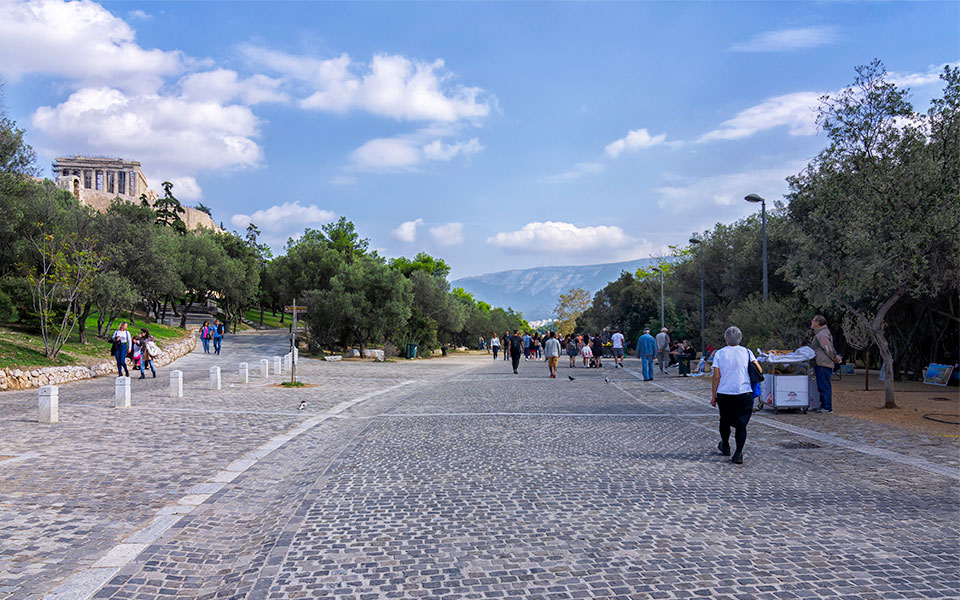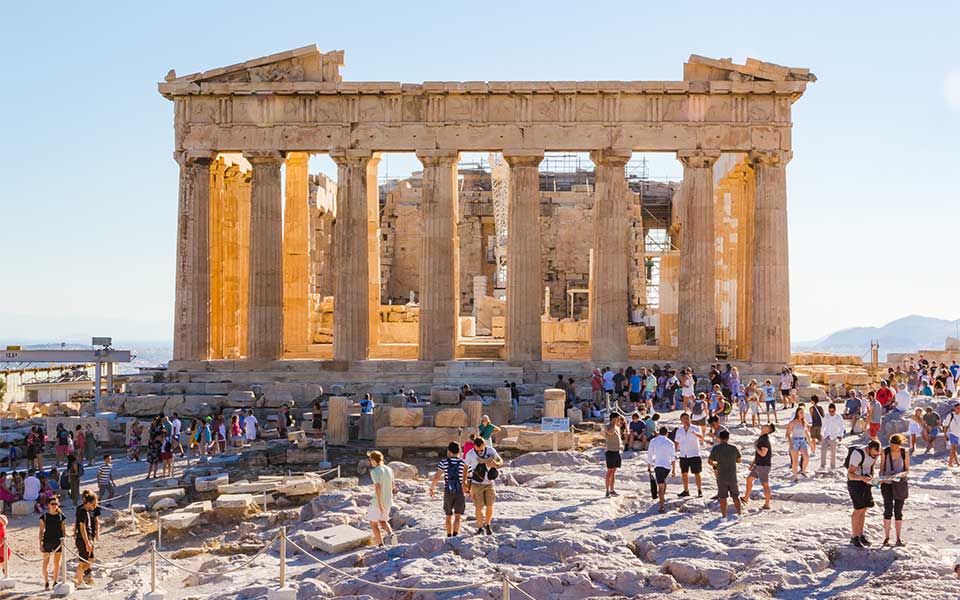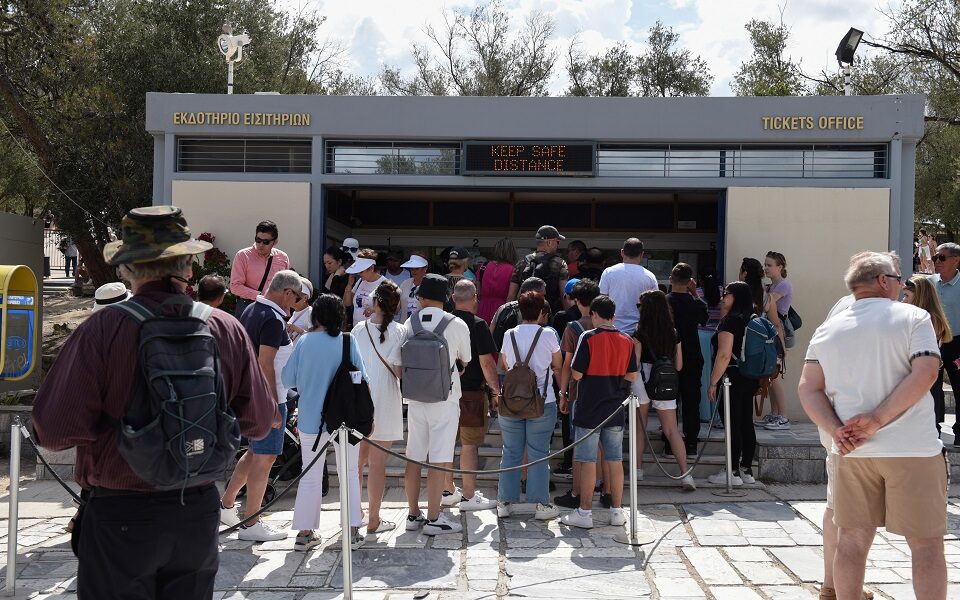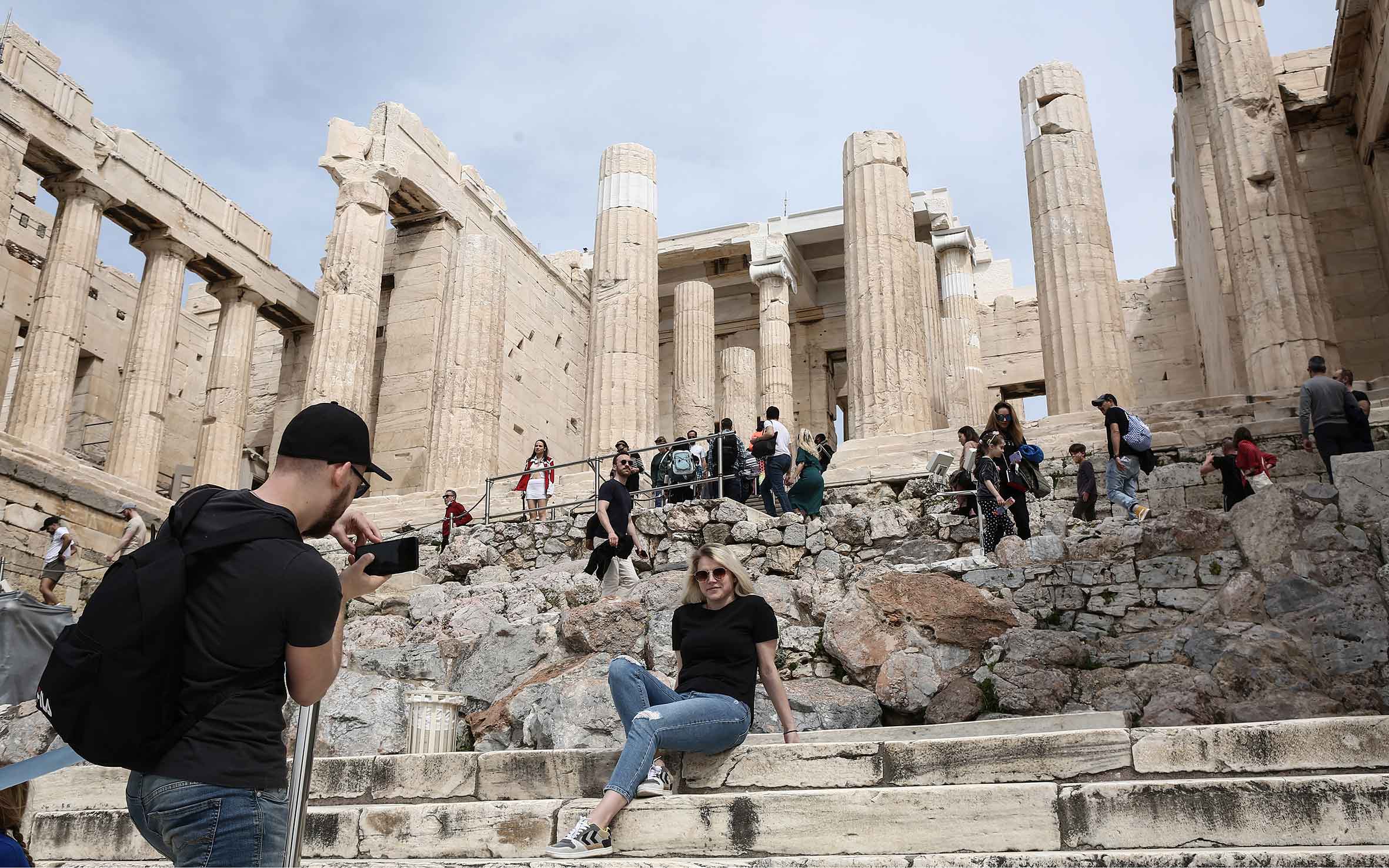It’s 9:30 in the morning and I’m striding purposefully up the cobbled pedestrian street of Dionissou Areopagitou, amidst a crowd of enthusiastic, chatty tourists. We pass the modern architectural marvel of the Acropolis Museum to our left, home to thousands of archaeological treasures from the “Sacred Rock” and its slopes, and continue heading along the Great Promenade in the direction of Filopappou Hill.
With the gentle din of rush hour traffic in the background, the sun is climbing in the sky, and the mercury is already punching above 30 degrees Celsius. For some, it’s already starting to feel unbearably hot. Indeed, summer 2024 has seen an unprecedented number of back-to-back heatwaves, from early June through July, with temperatures reaching well into the early forties.
Looming above us to the right are the iconic monuments of the Acropolis of Athens, a UNESCO World Heritage Site – the cornerstone of ancient Greek culture and Western Civilization. As I exchange pleasantries with those around me, I soon surmize that many of the tourists, hailing from just about every corner of the globe, are on their way to exploring the world-famous monuments – Greece’s most visited archaeological site.
Upon first impression, some are better prepared for the day ahead than others. I notice several families with young children, all wearing durable, practical footwear, ideal for scaling uneven surfaces, and loose-fitting clothing, with broad-brimmed hats, and big sunglasses. Some are even carrying small parasols to shield themselves from the hot Mediterranean sun. Others, however, are clearly unused to mid-summer temperatures in Greece. They walk in flimsy flip-flops and skimpy outfits, exposing too much skin, no hats, and no sunglasses. One wonders how they will fare under the midday sun.
I stop to top up my water bottle at the Hellenic Tourist Organization station at the lower end of Dionissou Areopagitou, where I catch up with a small family group from Michigan in the US. I ask them how they’re coping with the heat.
“The weather’s great, but it’s seriously hot!” one exclaims. “Summers back home in Michigan can be hot and stifling like this, so we’re more-or-less used to it,” she continues, “but we’re taking all the necessary precautions and drinking lots of water.” I see they’re well prepared, each sporting a wide-brimmed hat, sunglasses, and carrying small, battery-powered fans. I ask them about their trip in general. “We’re here in Athens for just a few days, so we want to pack in as much sightseeing as possible. We’re then heading over to Mykonos.”

© Shutterstock
Beating the Crowds
Back on the trail, I meet Greg and Tina, a young couple from England, who have already visited the site and are on their way down to the Acropolis Museum. They both look the part of seasoned adventurers, sporting natty backpacks, khaki cargo shorts, trail boots, and matching Indiana Jones-style Fedora hats.
“We were up with the sparrows this morning!” chimes Tina – lyrical English slang for an early rise. “We wanted to beat the crowds … and the heat,” she continues. “We were among the first to reach the top. It was utterly brilliant!” I asked them if they used one of the tour guides for the site.
“I studied Classical Civilization at school,” says Greg, “so I was quite confident about explaining the history of the monuments to Tina, and their respective contexts. I’ve always been interested in ancient history and read widely around the subject. We’ve brought along this old, dog-eared copy of ‘The Athenian Acropolis’ by Jeffrey Hurwit, which provides a comprehensive overview.” Tina cuts in, “We flew in from London yesterday, but we’re only in the capital for three days before heading off to Naxos for a week of sun, sea, and beaches! There’s so much to see and do in Athens.”
As they were on their way to the Acropolis Museum, I couldn’t resist but ask one more question about a topic that is dear to my heart: “Where do you stand on the issue of the Parthenon Sculptures?” Referring, of course, to the 5th century BC sculptures removed by Lord Elgin in the early 1800s and sold to the British Museum. Smiling, Greg sums up the feelings of many on the issue, “They’re sure to come home to Athens soon. It’s only a matter of time, don’t you think? I mean, there’s an air of inevitability about it.” Content with Greg’s erudite answer, I wish them both well for the remainder of their travels in Greece, and we part ways.

© Shutterstock
Queues and Ticketing
At the far end of Dionysiou Areopagitou, before turning right and up towards the main ticketing office at the foot of the Acropolis’ western slope, I notice a steady stream of light-blue tour buses arriving. I soon learn that many of these have come up from the port of Piraeus, dropping off large numbers of tourists from the cruise ships. With numbered paddles held aloft, tour guides act like shepherds, herding and corralling their eager charges into line and up the cobbled street.
I half expect the main entrance to be packed, and indeed there is a queue, but the area is far from being overwhelmed. Thanks to the new ticketing system introduced last September, visitors are allocated an hourly time slot, restricting the number of people on the archaeological site at any one time. Last July and August, the Acropolis and its slopes received an average of 23,000 visitors per day. In response, the Hellenic Ministry of Culture devised an ingenious new plan to protect the monuments from hordes of people visiting en masse while allowing access to the site at a staggered, hourly rate.
Crouched in the shade, I watch as orderly queues of visitors form 15 minutes or so before the hour. The atmosphere is jovial, with people fanning themselves, drinking thirstily from their water bottles, and slathering on more sunscreen before heading up the Sacred Rock. Once the hour mark is reached, the line moves slowly but steadily through the turnstiles.
According to the official e-ticket platform, administered by Hellenic Heritage, visitors are required to choose the exact time they want to visit the Acropolis. This is because the system imposes a daily limit on the number of visitors at 20,000, each time slot having a limited number of tickets (the morning time slots that are considered peak visiting hours will receive the largest number of visitors, such as the 08:00-09:00 time slot that will “accommodate” 3,000 persons).
Nearly one year on from the introduction of this new system, everything seems to be running rather well, despite the unbearable heat. Nevertheless, there is precious little shade here, aside from a scattering of trees, and visitors waiting for their time slot compete for space. There is a Red Cross First Aid station opposite the main ticket office, manned by two medics. For anyone suffering from heat exhaustion or dehydration, help is at hand.

© InTime News
An Experienced Hand
Next to the turnstiles is a small hut signposted licensed guides. It’s here that I meet the indefatigable Vassiliki Papadopoulou, sitting down to her packed lunch of fresh tomato, cucumber, and feta. I’m reluctant to disturb her during her well-earned break, but she is keen to talk. A veteran member of the Greek Union of Guides, Vassiliki is a tour de force, with decades of experience taking people around the Acropolis and its monuments.
Despite her advanced age and outwardly frail disposition, she has the energy and enthusiasm of someone half her years. I ask how she is coping with the heat, which she incredulously dismisses: “It’s our country! We’re used to this kind of heat!” Looking around at the red-faced tourists nearby, frantically fanning themselves, I inquire about today’s visitors and how they engage with the site.
“They want to know the details. They come from all corners of the globe, and they’re interested in learning more. Many have a good grounding in Classical Greek history; they know the main players, the main events, and so on. They’re curious to learn more details about how the monuments were built, the logistics, the meanings behind the decorative sculptures, as well as the historical context of Pericles’ great building plan in the 5th century BC.”
I quickly get the feeling that I could sit and talk to Vassiliki for hours. During our lengthy conversation, she flies off in all kinds of fanciful directions. We veer from discussing the role of the gods in Greek antiquity, to the Sophists, the Peloponnesian War, the Great Plague of Athens, and back again. Before becoming a guide, she served as a history teacher in the Greek state school system, and it’s easy to understand why she takes such pride in her job, while many her age have long since retired. History, especially the history of Classical Greece, has been her life’s passion.
“We do the best we can. We guide the visitors from shade to shade on the site, so they don’t become too hot or exhausted. Some are better equipped to deal with the heat than others. There is water at the top, so visitors can refill their bottles, and there are toilets, a vending machine, and another first aid station for emergencies,” she concludes.
Another friendly tour guide passes as I bid goodbye to Vassiliki. Without breaking stride, he tells me that the visitors keep coming despite the temperatures. Nothing seems to quell their enthusiasm, it seems.

© InTime News
Trip of a Lifetime
As I make my way back down the Great Promenade amidst an excited group of French tourists, enthusiastically swapping information about their experiences in the presence of Greece’s most iconic ancient monuments, I plot a course for the nearby historic neighborhood of Plaka for some much-needed refreshment. At a bar overlooking the open trenches of the ongoing American excavation site at the ancient Agora, I meet up with Tim and Michelle Cook from Sydney, Australia, enjoying a cold beer in the late afternoon sun.
Science teachers by trade, Tim and Michelle are on the very last day of a three-week Mediterranean Odyssey. “We’re flying back home tonight at 11. It’s been an incredible trip. We started in Barcelona, embarking on a 14-day cruise of the Mediterranean. We’ve visited islands in the Aegean and sites along the Turkish coast. Athens was our last stop,” said Tim, sporting an eye-catching turquoise golfing shirt.
I asked them if they’d visited the Acropolis. “Of course!” exclaimed Michelle. “We booked our tour online through ‘Athens Walking Tours’ and arrived at the gate at 8 o’clock this morning. The guide was fantastic. We were in a relatively small group – 19 in total – and we all had audio devices, so we could hear everything clearly. Even though it was early in the morning, it was still quite hot at the top.” I asked her what she thought of the new concrete walkways.
“Slippery. You need to pay close attention to where you’re walking, but the guide was good, taking care to shepherd us from shady area to shady area. It gets quite busy later in the morning, with lots of people milling about, but all the on-site staff are friendly and accommodating.”
Both were amazed at the sheer number of archaeological sites on offer in the Greek capital. “I imagine every time you put a shovel in the ground, you’ll come up with something historical,” muses Tim. “There’s just so much to see,” adds Michelle. “Yesterday, we visited the serene Temple of Poseidon at Sounion. Today has been the perfect end to a wonderful trip.”
I ask them about the heat. “We’re used to this kind of heat during the long, hot summers back home,” says Tim. “But even though we’ve had such an incredible time, we’re looking forward to getting back to Australia, to family and friends, and the balmy mid-winter temperatures of the southern hemisphere that hover around the low to mid-twenties!”












